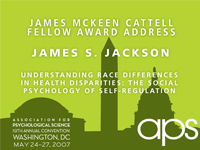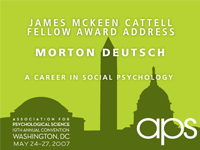Recent Advances in False Memory Research
The “Recent Advances in False Memory Research” symposium at the APS 19th Annual Convention showcased innovative research being conducted around the world on this fascinating topic. Presenters explored complex issues surrounding the development, understanding, neural basis, and underlying psychological mechanisms of false memories.
 Cara Laney, University of Leicester, discussed “Implanting False Memories for Emotional Events Using a Simple False Feedback Manipulation.” In her research, Laney used a relatively simple procedure to implant emotional false memories in participants. During the first of two sessions, participants completed simple questionnaires about their past. During the second session, they were given false feedback about their history, such as “the childhood experience that contributed most to your emotional development is that you witnessed a physically violent fight between your parents.” Minimal statements such as this led participants who had never witnessed these emotional events to significantly increase their confidence that the event had occurred. This has implications for emotional testimony in trials because the emotionality of memories often is seen as indicative of their truth. But, said Laney, “false memories can be just as emotional as true memories, such that emotion is no guarantee of memory accuracy.”
Cara Laney, University of Leicester, discussed “Implanting False Memories for Emotional Events Using a Simple False Feedback Manipulation.” In her research, Laney used a relatively simple procedure to implant emotional false memories in participants. During the first of two sessions, participants completed simple questionnaires about their past. During the second session, they were given false feedback about their history, such as “the childhood experience that contributed most to your emotional development is that you witnessed a physically violent fight between your parents.” Minimal statements such as this led participants who had never witnessed these emotional events to significantly increase their confidence that the event had occurred. This has implications for emotional testimony in trials because the emotionality of memories often is seen as indicative of their truth. But, said Laney, “false memories can be just as emotional as true memories, such that emotion is no guarantee of memory accuracy.”
Suzanne O. Kaasa, University of California, Irvine, explored people’s inability to determine the veracity of memories in her talk, “Can People Distinguish Between True, False, and Fabricated Memories?” Kaasa and her colleagues were not able to find any previous studies in which the ability to distinguish between true memories, false memories (i.e., memories that a person believes, but that are not actually true), and fabricated memories (i.e., known lies) was examined using all three types of memories simultaneously. In her study, participants were able to accurately determine the memories’ origin less than half of the time for true memories, about a third of the time for fabricated memories, and about a quarter of the time for false memories. Participants appeared to use “cues from the memories such as detail, plausibility, and emotionality” when making their largely inaccurate judgments of truth.
Craig Stark, Johns Hopkins University, discussed how normal encoding and retrieval processes can lead to false memories. In his talk, “Examining the Neural Basis of the Misinformation Effect,” Stark reported that he and colleague Yoko Okado found that false memories were formed during encoding of critical items because there was “weaker encoding of the source [of the memory] during the misinformation phase than during the original phase” and because there was “stronger encoding of the critical item during the misinformation phase than during the original phase.” In addition, false memories were retrieved because aspects of the sensory information were not sufficiently reactivated during retrieval to allow a determination of whether the source was the original phase or the misinformation phase. Therefore, neural processes during both encoding and retrieval appear to contribute to the misinformation effect.
APS Fellow Maryanne Garry, Victoria University of Wellington, offered cutting-edge findings in her talk, “Psychotropic Placebos Affect Susceptibility to Memory Distortion: Underlying Mechanisms.” In their research, Garry and her colleagues told participants they would be taking either an inactive or active form of a drug that enhances cognitive abilities. The more the participants believed in the cognitive-enhancing ability of the drug and the higher their innate working memory capacity, the more the participants were misled by misinformation about a target event, and the longer they took to respond to questions about that event. It appears as though participants who believe that they have enhanced cognitive abilities and who have a high working memory capacity spend a relatively long time deciding whether their memory came from a target event or a subsequent misleading event, which implicates source monitoring decisions as the underlying mechanisms to the misinformation effect.
APS Past President Elizabeth Loftus, University of California, Irvine, joined the symposium as a discussant. She brought the symposia to a close by drawing connections between the four research presentations and emphasizing implications for further research.




Comments
This is very helpful since we are aiming to research how false memory can actually make a person believe of what he is recalling. But may I know how can we determine if something is a misinformation?
I would like to share an example of a false memory that I implanted myself into myself involuntarily of course, this progressively in the span of 30 years.
I was able to get the proof in writing from the original document that I have not lied in it while I have been able to make myself believe that I did.
I had the vivid memory that I had been cheating while I have not been.
This is for me the proof that false memories are a real phenomena.
APS regularly opens certain online articles for discussion on our website. Effective February 2021, you must be a logged-in APS member to post comments. By posting a comment, you agree to our Community Guidelines and the display of your profile information, including your name and affiliation. Any opinions, findings, conclusions, or recommendations present in article comments are those of the writers and do not necessarily reflect the views of APS or the article’s author. For more information, please see our Community Guidelines.
Please login with your APS account to comment.